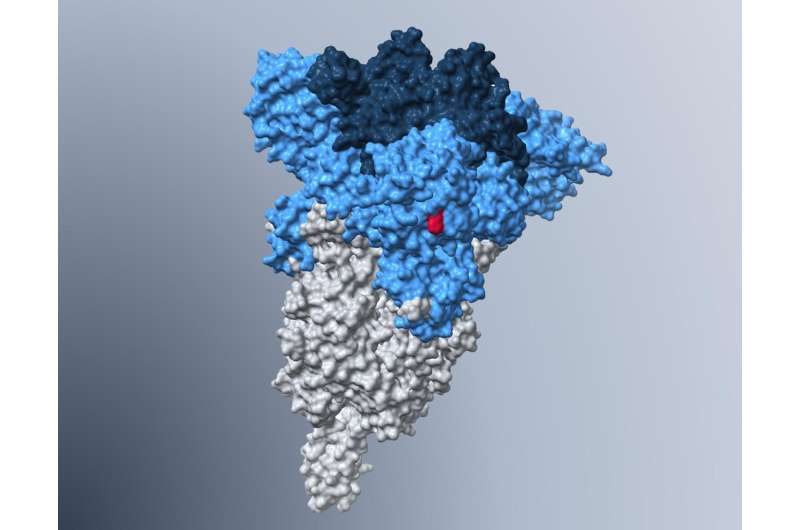This article has been reviewed according to Science X's editorial process and policies. Editors have highlighted the following attributes while ensuring the content's credibility:
fact-checked
peer-reviewed publication
trusted source
proofread
Mutation in spike protein allows omicron subvariant BA.5 to efficiently infect lung cells

Omicron-derived virus variants are currently responsible for most SARS-CoV-2 infections worldwide. Compared to earlier virus variants, omicron rarely causes severe disease. According to current knowledge, a major reason for this is that omicron infects lung cells less efficiently and therefore causes pneumonia less frequently.
However, an international team including scientists from the German Primate Center—Leibniz Institute for Primate Research, has now identified a mutation in the spike protein of the omicron subvariant BA.5 that enables the virus to efficiently infect lung cells again. Published in the journal Nature Communications, the study demonstrates that, over the course of evolution of omicron subvariants, viruses may arise that regain the ability to effectively spread in the lung and cause severe illness in risk patients and people with insufficient immunity.
Omicron subvariants
The BA.1 and BA.2 omicron subvariants dominated the COVID-19 pandemic in the first half of 2022. Compared to previously circulating variants such as the delta variant, these omicron subvariants have in common that they cannot efficiently infect lung cells. Until now, it was unclear whether the omicron subvariant BA.5, which displaced other omicron subvariants in autumn 2022, has a similarly poor ability to infect lung cells.
A team of scientists led by Markus Hoffmann and Stefan Pöhlmann from the German Primate Center has now shown that, due to a mutation of the spike protein, BA.5 actually infects lung cells much more efficiently than previous omicron subvariants.
Mutation in the spike protein
The researchers found that the spike protein of the omicron subvariant BA.5 is cleaved more efficiently than in earlier subvariants. Furthermore, the spike protein of BA.5 mediates entry of the virus into lung cells and fuses lung cells with higher efficiency. To investigate how the virus enters lung cells, the researchers used so-called "pseudo-viruses," a safe model system of the real pathogen.
Markus Hoffmann, first author of the study, explains: "We found that BA.5 has acquired a mutation that allows the virus to penetrate lung cells more efficiently than the previously dominant omicron subvariants. Thus, the ongoing evolution of omicron subvariants may produce viruses in the future that efficiently spread into the lower respiratory tract and may cause severe disease, at least in patients without effective immune protection." The altered properties of omicron BA.5 are due to a key mutation known as "H69Δ/V70Δ".
Confirmation with the real virus
To confirm the results with real viruses, Christian Drosten's team at the Virology Department of the Charité—Berlin University Hospital carried out further experiments. The researchers showed that real viruses of the BA.5 strain also infect lung cells efficiently, corroborating the results from Göttingen.
To determine whether omicron BA.5 also infects lung cells in living organisms, researchers at the University of Iowa in the U.S. compared the lungs of mice that were infected with BA.5 with those that received other subvariants. They found that BA.5 replicated up to 1,000 times more efficiently in the lungs of mice compared to earlier omicron subvariants.
In addition, experiments with ferrets at the Friedrich-Loeffler-Institut in Greifswald—Insel Riems, Germany, revealed that the BA.5 subvariant spreads more efficiently in the upper respiratory tract than earlier virus variants.
"All together, this suggests that similarly to other omicron subvariants, BA.5 is highly contagious and has additionally evolved the ability to efficiently infect lung cells," says Stefan Pöhlmann, head of the Infection Biology Unit at the German Primate Center. "The further evolution of omicron subvariants should therefore be monitored closely in order to be able to quickly identify variants with increased risk potential."
More information: Markus Hoffmann et al, Omicron subvariant BA.5 efficiently infects lung cells, Nature Communications (2023). DOI: 10.1038/s41467-023-39147-4





















